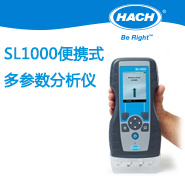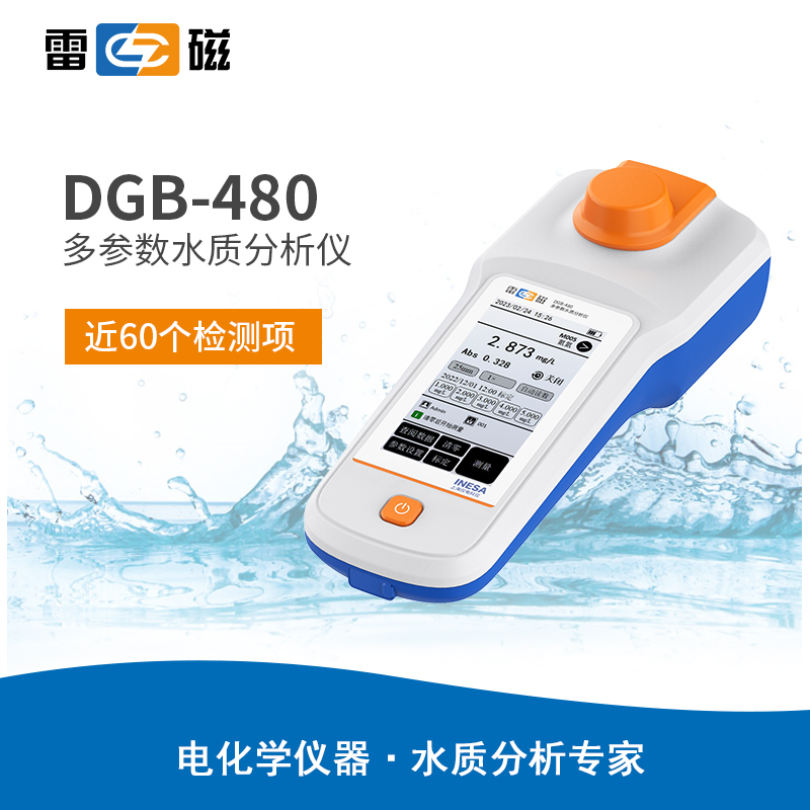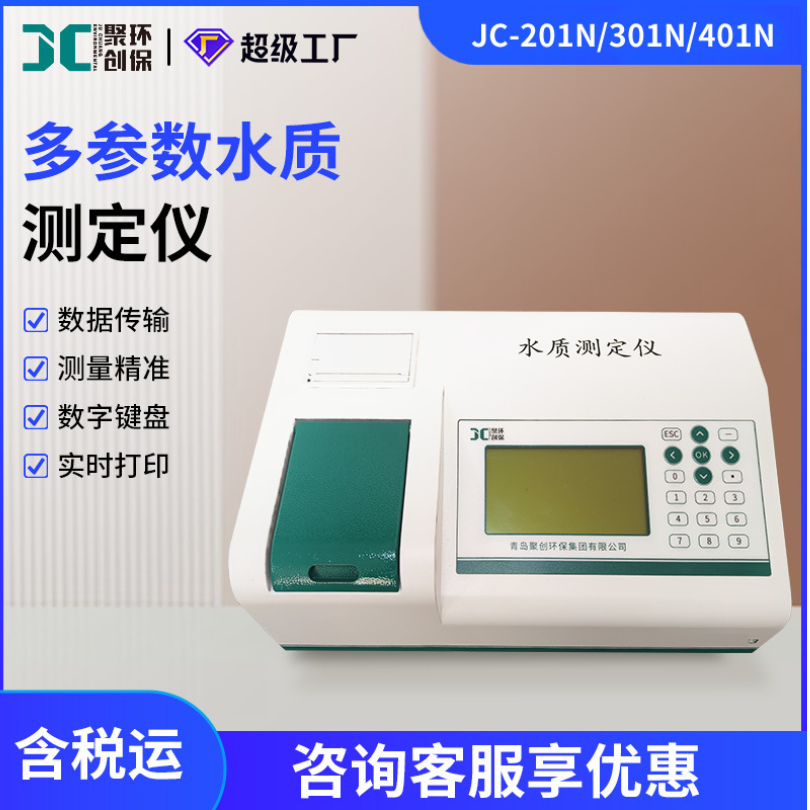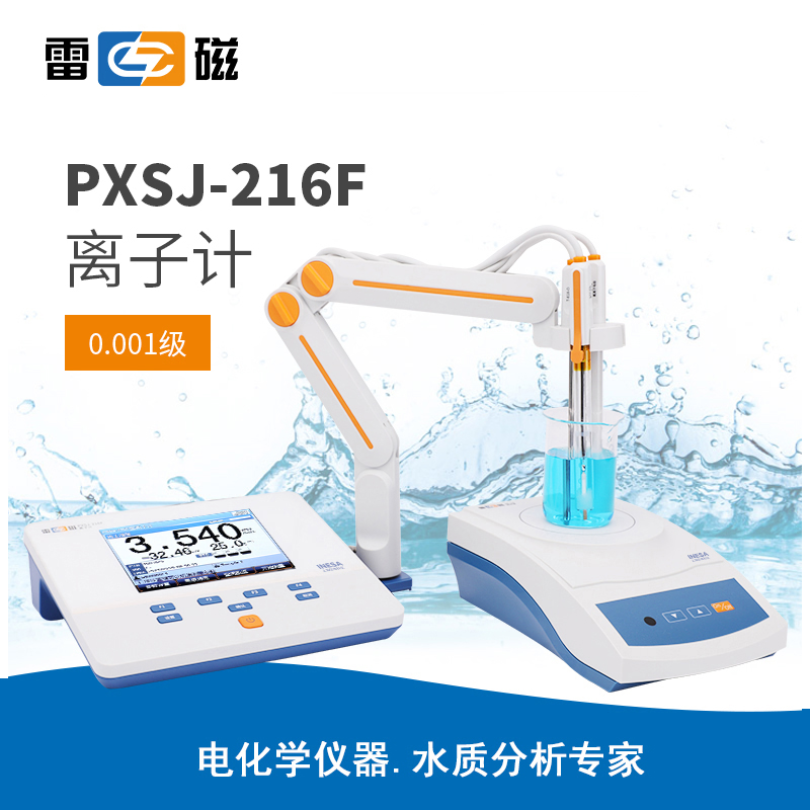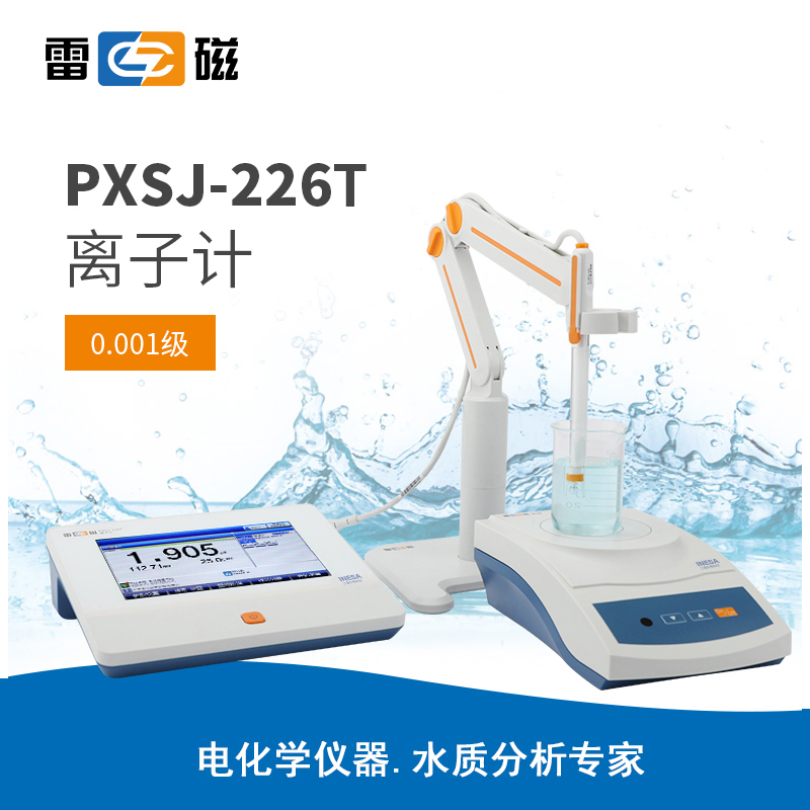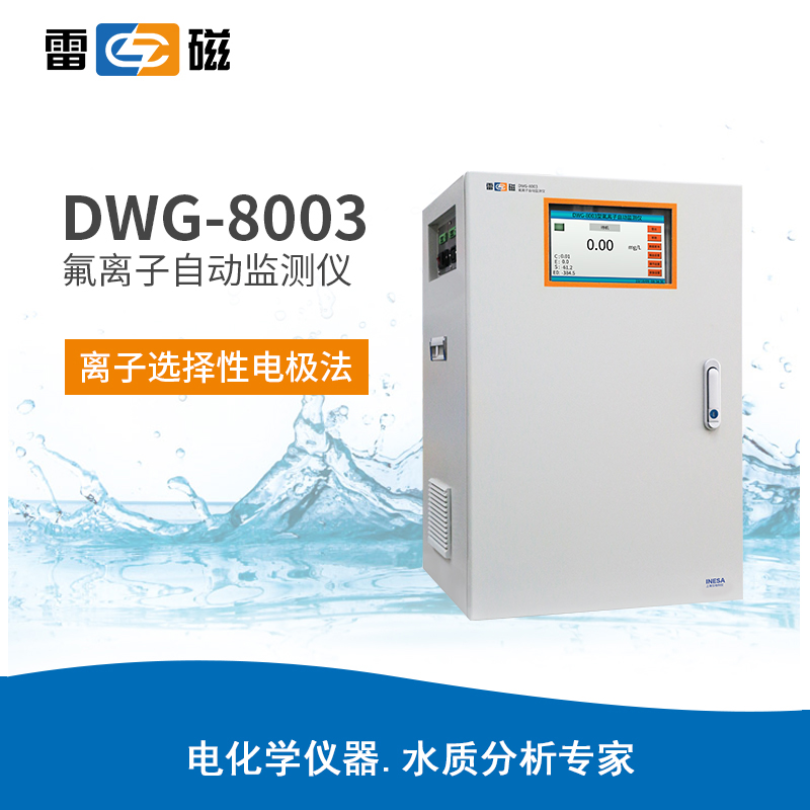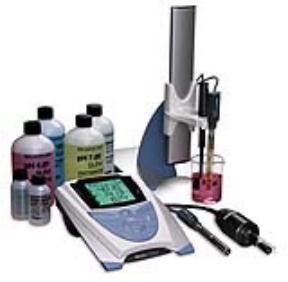
方案详情
文
本文章详细介绍了果汁中钙离子的测定,包括校准液、水样的准备,校准和测量过程,以及电极和仪表的维护等内容。
方案详情

Calcium inFruit JuiceCalcium inFruit Juice Calcium inFruit Juice Star SeriesMethod Note M-1418-E 03/05 RevB Key Words Introduction Calibration and Analysis 1. Allow all the standards and the samples to attain room temperature for precise measurements since themeasurement is temperature sensitive. 2.Calibrate the meter using the 4 ppm followed by the 40 ppm standard, stirring the standards at agentle and uniform rate. 3.Place the electrode and stirrer into the beaker with the 4 ppm standard such that the electrode tip isfully immersed in the solution. The stirrer should be positioned slightly below the tip of the electrode.Press the STIRRER key on the meter to turn the stirrer on. Press the CALIBRATE key. ·Free Calcium· Fruit Juice·Orionionplus"Sure-Flowplastic mem-brane combina-tion CalciumElectrode This method provides rapid, uncomplicated determinations for the free calcium ion in fruit juice. Thedirect measurement of ions using ion selective electrode is a well established frequently used as a standardmethod of analysis as a quality control step and to fulfill labeling requirements. This procedure eliminatesinterferences associated with presence of color and solids. Recommended Equipment Cat. No. Calcium in Milk Application Package (includes all items with a catalog number) 1010149 4W.ait for a stable reading (1-2 minutes). Enter the standard value of“4” using the UP and DOWNarrow keys and the DECIMAL/DIGIT key. 1. 4 Star benchtop pH/ISE meter 1115000 5. Press the CALIBRATE key to accept the 4 ppm standard and press the STIRRER key to turn thestirrer off. 2. ionplus calcium electrode 9720BNWP 3. Orion benchtop stirrer (or magnetic stir plate and bar) 096019 6.Rinse electrode and stirrer thoroughly with deionized water. Gently remove excess solution from theouter sleeve of the electrode by dabbing with a clean paper tissue. Do not wipe or rub the sensingelement of the electrode. 4. Benchtop electrode stand 1110001 5. Beakers (50 mL) 7.Place the probe and stirrer into the beaker with the 40 ppm standard such that the electrode tip isfully immersed in the solution. The stirrer should be positioned slightly below the tip of the electrode.Press the STIRRER key on the meter to turn the stirrer on. 6. Graduated cylinder (30 mL) 7. Pipettes (1 mL, 10 mL, and 50 mL) 8.Volumetric flasks (100mL and 200 mL) 8.Wait for a stable reading (1-2 minutes). Enter the standard value of“40”using the UP and DOWNarrow keys and the DECIMAL/DIGIT key. Required Solutions Cat. No. 9..Press the MEASURE key to accept the 40ppm standard and to move to the measure mode of themeter. Press the STIRRER key to turn the stirrer off. 1. 0.1M Calcium standard as CaCl2 922006 2. 2. ISA (Ionic Strength Adjustor) for calcium electrode 932011 10. Rinse electrode and stirrer thoroughly with deionized water. Gently remove excess solution from theouter sleeve of the electrode by dabbing with a clean paper tissue. Do not wipe or rub the sensingelement of the electrode. 3. 3. Reference Filling Solution, Optimum Results A 900061 4.Deionized water 11. Place the probe and stirrer in a prepared sample with the electrode tip fully immersed in the solution.Press the MEASURE key on the meter; the stirrer will turn on. The ISE: ppm icon will flash as themeasurement is being made. The ISE: ppm icon will become solid and the display value will freezewhen a stable reading is achieved. This value is logged and printed automatically and the stirrer turnsoff automatically. Calibration Standard Preparation 1. To prepare a 40 ppm calcium standard, pipette 1 mL of the 4000 ppm (0.1M) calcium standard intoa 100 mL volumetric flask. Add 2 mL calcium ISA into the same flask. Dilute to the mark with thedeionized water. Mix well. 12. Repeat steps 10 and 11 for additional samples. Upon completion of samples, rinse electrode withdeionized water and store the electrode according to instructions in the Electrode Storage section ofthis method note. 2.To prepare a 4 ppm calcium standard pipette 10 mL of the 40 ppm calcium standard into a 100 mL volumetric flask. Add 2 mL calcium ISA into the same flask. Dilute to the mark with the deionized water. Mix well. 3.Using a graduated cylinder transfer 30 mL of the 4ppm and 40ppm calcium standards into the each 50 mL beaker. Sample Preparation 1. Pipette 50 ml of the fruit juice into a 200 volumetric flask. Add 4 ml calcium ISA to the same flask.Dilute to the mark with deionized water. Mix well. 2.Using a graduated cylinder, measure 30 ml of the sample into a beaker. ( Environmental Instruments Water Analysis Instruments ) ( 1 66 Cummings C enterBeverly, MA 01915 USA M-1 4 1 8 -E 0 3/05 Rev B 248110-001 ) Toll Free:1-800-225-1480Tel: 1-978-232-6000Dom. Fax:1-978-232-6015IntlFax:978-232-6031www.thermo.com/waterO 2005 Thermo Electron Corporation21All rights reserved. RegisteredIs O9001:2000 Results Five aliquots of prepared fruit juice were measured for free calcium. The data in the table below isrepresentative of the results expected for free calcium in fruit juice. Prepared milk ppm calcium Sample #1: 10.1 Sample #2: 10.3 Sample #3: 10.5Sample #4: 10.7Sample #5: 10,4 Mean: 10.4 Standard Deviation: 0.2 %CV 2.2 Note: the average result ofthe ppm free calcium in fruit juice was obtained by multiplying the above by the dilution ratio of4. The final average result was 41.6 ppm free calcium in fruit juice. Electrode Storage For brief storage periods between sample measurements, store the electrode in 0.004 % (0.001 M) calciumstandard. The filling solution in the electrode should not be allowed to evaporate, which causes crystallization.For longer storage periods, refer to the electrode instruction manual. When the electrode is not performing,disassemble and reassemble the electrode, taking care not to over tighten the cap. If the electrode still doesnot perform as described, replace the sensing module and repeat the slope check. If the slope check still fails,replace the electrode handle. Equipment Setup Electrode Setup- ionplus electrode 1. Remove the electrode sensing module from the plastic vial package. Make sure both o-rings are in place onthe sensing module. Remove the electrode handle from the box. 2.Grasp the outer sleeve of the electrode handle, with the fill hole end towards the electrode cap, and gentlypush the electrode inner stem through the outer sleeve. 3.Slide the outer sleeve, spring, and cap down the electrode cable until the outer sleeve is beyond the innerstem. 4 With one hand, grasp the middle of the inner stem without touching the reference pellet. With the otherhand, screw the sensing module onto the stem until it stops and the sensing module is flush against thestem. Then tighten an additional one-quarter turn and stop. Do not over tighten. The sensing moduleshould be firmly attached to the inner stem. 5. Holding the electrode cable, slide the outer sleeve, spring and cap over the inner stem. 6 With one hand grasp the outer sleeve; do not touch the sensing membrane. With the other hand, pull onthe cable and gently screw the cap onto the inner stem. Stop when resistance is felt. Do not over tightenor continue to turn the cap, the cap will not completely stop. If the inner body turns at all, the cap is tootight and removal of the cap and reassembly is necessary. 7.Lift the filling solution bottle's spout to a vertical position. 8 Insert the spout into the filling hole in the outer sleeve of the electrode and add a small amount of fillingsolution to the chamber. Then tip the electrode to moisten the o-ring at the top and return electrode to avertical position. 9. Holding the electrode by the barrel with one hand, use the thumb to push down on the electrode cap,allowing a few drops of filling solution to drain wetting the inner cone. 10. Fill outer body with Optimum Result A filling solution to approximately 14 full. Release the electrode capallowing the electrode’s outer sleeve to return to its original position immediately. If the outer sleeve doesnot return to its original position, immediately check to see if the o-ring is moist and repeat steps 8-10until the outer sleeve has returned to its original position. Add more filling solution until the amount offilling solution within the electrode body is level with the bottom edge of the electrode filling hole. 11. Check the membrane surface of the sensing module to make sure it is dark and homogeneous with nobubbles on the inner surface. To ensure electrode continuity, grasp the outer sleeve and electrode cap andshake the sensing module end firmly. Meter Setup-4 star benchtop For initial meter setup, follow the steps in the Quick Reference Guide, which is attached to the meter itself.The Quick Start Guide included with each meter also contains a layout of the meter keypad for reference.The words in this method represented in all capital letters, such as POWER, indicate a key on the meter,and words in quotations such as“Unit”indicate information on the meter display. 1. Connect the electrode to the meter. 2.Connect the stirrer to the meter. 3. Press the POWER key on the meter to turn the meter on. .4 Note that the arrow on the left of the screen indicates the active line. If the top line is not active, press theLINE SELECTION key to change the selected line to the top line. Then press the UP or DOWN arrowkeys to change the measurement mode of the top line to ISE. 5. Press the SETUP key to enter ISE setup. Press the LINE SELECTION key to select the bottom line.Press the UP or DOWN arrow keys to select “3”for “rES” which is an abbreviation for resolution ornumber of significant digits. Press the LINE SELECTION key to accept value. 6 Press the LINE SELECTION key to select the middle line, and press the DOWN arrow key to select “nLIn”which is an abbreviation for non-linear blank correction. Press the LINE SELECTION key to select the bottom line. Press UP or DOWN arrow keys to select “off’for “nL In". Press the LINE SELECTION key to accept value. 8 Press the LINE SELECTION key to select middle line, and press the DOWN arrow key to select “rAng"which is an abbreviation for measurement range. 9 Press the LINE SELECTION key to select the bottom line. Press the UP or DOWN arrow keys to select“HigH”for “rAng". Press the LINE SELECTION key to accept value. 10. Press the LINE SELECTION key to select the middle line, and press the DOWN arrow key to select“Unit”. 11. Press the LINE SELECTION key to select the bottom line. Press the UP or DOWN arrow keys to select“PEr”(ppm) for“Unit. Press the LINE SELECTION key to accept value. 12. Press the MEASURE key to return to the measurement mode. If all steps were followed correctly themeter display will show three digits in the top line and“ISE: PEr"to the right of the top line. The meterand electrode are now ready for calibration. Note: The Orion Benchtop Stirrer must be turned on in General Instrument Setup before analysis, please see the Quickstart Guide For instructions. www.thermo.com of of of of
确定

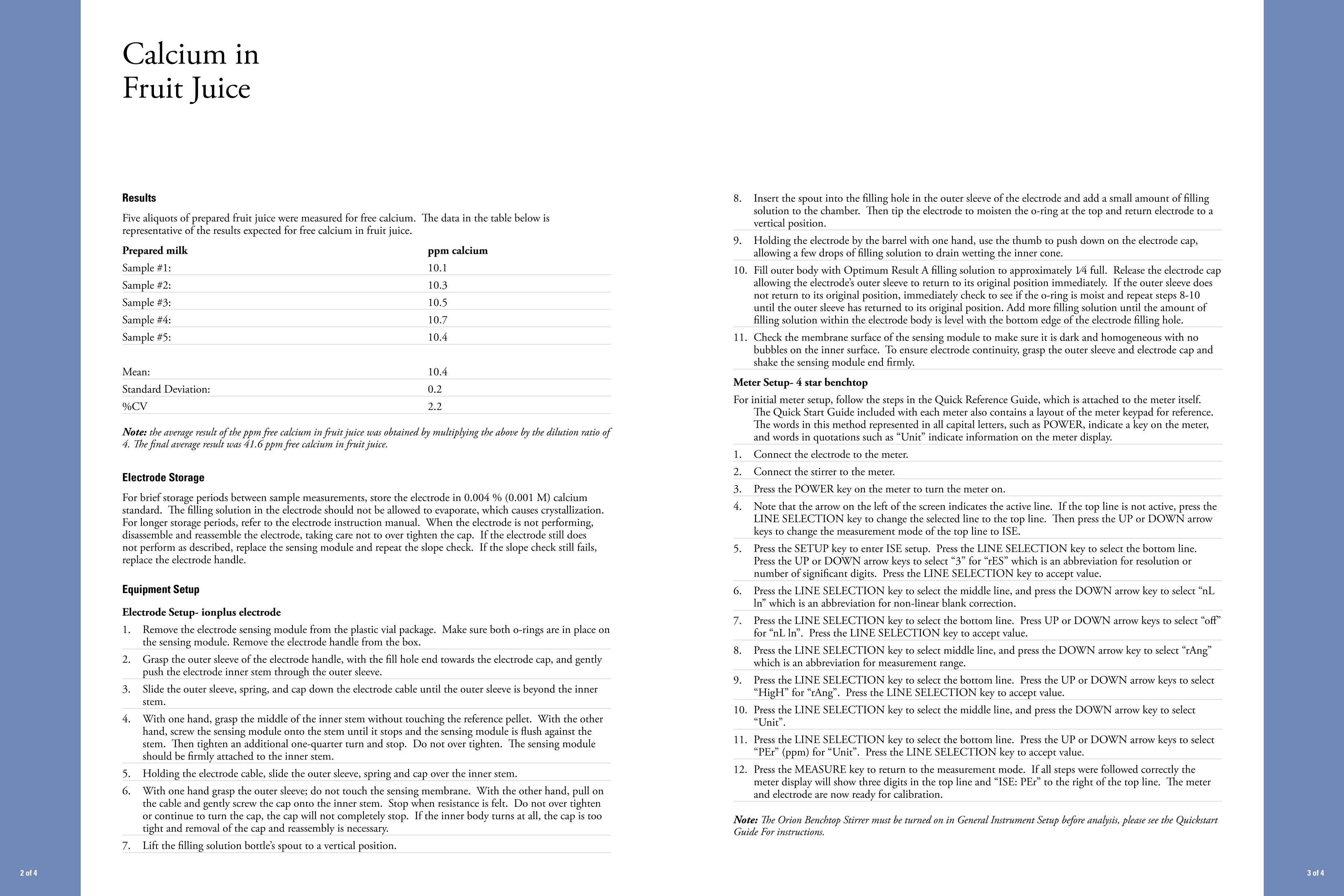
还剩1页未读,是否继续阅读?
赛默飞中国实验室产品事业部为您提供《果汁中钙离子检测方案 》,该方案主要用于果蔬汁类及其饮料中营养成分检测,参考标准--,《果汁中钙离子检测方案 》用到的仪器有台式pH/ORP/ISE/溶解氧/电导率测量仪、Orion 4-Star台式(便携式)pH/离子浓度测量仪
推荐专场
相关方案
更多
该厂商其他方案
更多











